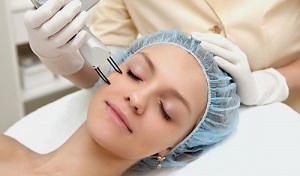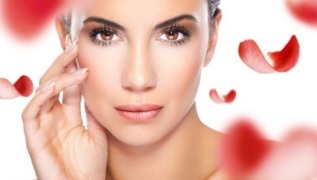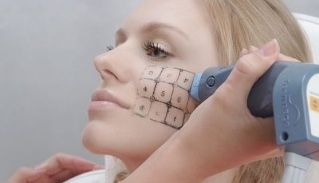Sorry, I still look young - and wrinkles, age spots and other cosmetic blemishes are already occurring. You can get rid of them by performing a fractional rejuvenation procedure. How does it work?
Always want to look beautiful, regardless of age. But time passes relentlessly and is reflected in appearance. Over the years, the skin becomes less elastic, wrinkles, aging spots and other visible defects appear. Modern technologies make it possible to prolong youth by using the effects of lasers on problem areas. Let’s find out about partial rejuvenation: what it is, how it goes, and the results of this procedure.
What it is

Over time, cells lose their activity, slowing down regeneration processes. It is necessary to return the youth not only visually, but also to help the cell to recover and continue active work. Only in this way will the skin acquire a healthy look, firm and smooth.
The first partial laser rejuvenation was performed in 2004. It was developed specifically to treat the signs of aging. After the first studies and results with excellent effect were obtained, the procedure was actively used in many beauty salons. The action is completely safe, effectively combating cosmetic defects.
Benefits and Enforcement Techniques
Laser rejuvenation has several advantages that show why this aging method is worth using:
- One procedure is enough to achieve good results;
- anesthesia is not used;
- is not an operation;
- safe, no side effects;
- does not require a long rehabilitation period;
- effects are similar to the Botox injection technique;
- takes a long time.
This rejuvenation method is called partial because it only affects problem areas exposed to small laser beams. Untouched sites, namely epidermal cells, become active, multiply, and quickly heal laser-treated sites. The total rehabilitation period lasts for a maximum of three days, depending on the condition of the skin. Collagen is actively produced in cells, which in turn:
- smooths wrinkles, wrinkles;
- tightened skin;
- smoothes the oval of the face;
- Pigment spots lighten.

The procedure does not cause any inconvenience, is painless, and the redness disappears quickly. Partial laser action is somewhat similar to the method of surface beam coating, but it has more capabilities and is more efficient. Otherwise it is called photorejuvenation.
The principle of operation is that damaged skin suffers from thermal shock at a sufficiently high temperature. The cosmetologist uses a small apparatus on which the elements through which the laser beams penetrate are mounted. Because the rays are very hot, the skin is treated very quickly to avoid burns.
The result depends on the severity of the defects. The deeper the wrinkles, the more treatment will be needed. The healing time also depends on the person and their health condition.
Exposure of a laser beam thinner than two hundred microns to the skin is completely sufficient to create a new layer of epidermis at the treated site. The rays are similar to a thin grid and are applied exclusively to problem areas, on the face, neck, legs, around the eyes. This grid allows the surrounding areas not to be affected and allows them to activate cell healing and regeneration.
Types of photorejuvenation
In the field of cosmetology, two types of fractional thermolysis are used, which differ from each other in the degree of effect and in the main properties.
- Ablation method- thermal activity affects the upper layers of the skin, cells.
- Irregular rejuvenation- Laser beams act exclusively on the deep layers of the epidermis.
Many partial machines today use CO2 laser beams. They are more advanced and have moved to a new level in the last few years. Before starting the procedure, it is worth finding out which laser will be used, the quality and efficiency of which depend on it.
To achieve the best effect, it is recommended to combine two types of fractional thermolysis - ablation and non-relativity. Double stroke feet help improve the result and maintain it for a long time. Thanks to modern equipment, beauticians develop skin type and health rejuvenation programs.
When to opt out

Like any other intervention in natural body work, fractional facial rejuvenation has its own contraindications. Ft procedures should not be performed if:
- you are pregnant;
- suffer from epilepsy;
- for oncology;
- severe inflammation of the skin with psoriasis;
- with herpes;
- if you have recently experienced chemical facial skin;
- or sunbathing;
- has vitiligo;
- Chronic diseases such as diabetes, poor blood clotting.
Contraindications should not be ignored, as the existing problem can be greatly exacerbated by heat exposure and worsen the situation.
What to expect
Photothermolysis is designed to lift the face and rejuvenate the skin. With the help of cosmetic procedures, it is immediately noticeable how the skin is stretched, wrinkles disappear in a few days, clearer contours. To make the effect even better, it is recommended to perform several procedures with a difference of one month to six months, depending on the first result.
To improve the condition of the face, many cosmetologists recommend combining partial types of CO2 laser exposure. This in turn allows for a long-term preservation of youth, prolongs skin regeneration processes and prevents premature aging.
The patient recovers quickly enough, within one week. The time also depends directly on the type chosen. For the first day or two, the skin becomes noticeably swollen, redness occurs. However, after 4-5 days, the dead cells leave the skin, and the epidermis is covered with a new and healthy layer. If you coordinate your actions correctly, choose a good, responsible beautician, find out if there are no contraindications, then the photoorejuvenation procedure will only be good.
















































































